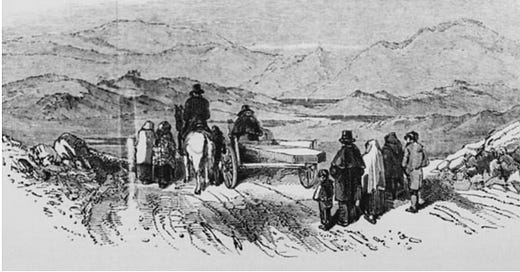There is nothing wrong with returning to our original source, and looking for living water.
-Caitlin Matthews
Image from GETTY Images
Imagine living in a society where…
…the clocks are stopped in a home the moment a death occurs.
…laments for the dead make up a large portion of the musical cannon.
…proper grieving is so valued that a respected position in the community is one who wails, or keens; not only to help others express their grief - but to allow the deceased’s spirit to cross the threshold to the other side.
…ancient laws include special provisions for crossing neighbors’ lands in the case of funerals, in a manner otherwise forbidden.
…you do not utter the name of a deceased person, without uttering an invocation for the peace of their soul.
Such is life, and death, in Ireland.
For the Irish, death seems as much an accepted and interwoven aspect of life as anything else. In fact, if an Irish person tells you you look deadly, consider it a compliment.
This is a stark contrast to much of the modern world, where death lurks in the shadows. The increase of medicines and technologies that give us seemingly more control over death, as well as the outsourcing of death care has taken this aspect of life out-of-sight, out-of-mind. What was once a normal, integral aspect of our lives across all cultures (aging, death, and healthy grieving processes) has become much more distant from the cultural norm.
Maggie Callahan and Patricia Kelley write in their book, Final Gifts:
Death has become remote, no longer an integral part of life, but a fearsome and unwelcome visitor. Once, the business of dying was a part of the business of living. With several generations of a family often residing under the same roof, children helped Mom and Dad care for Grandmother, who spent her last months on a bed in the living room.
Many are now wondering if this lifestyle change to something more individualistic and less connected with the realities of death isn’t interfering with a healthy relationship with it, as well as healthy grieving. We see a resurgence of interest in practices that look very much like those in cultures more connected to their ancient ways, that still have care of their own dead and practices around grief interwoven into life.
“We live in a time when more and more people are beginning to reappreciate the wisdom of their ancestral traditions"…
…says Caitlín Matthews, in her book, The Celtic Spirit.
"This is a very beautiful and needful thing for those who have been without spiritual direction, or who have tried without avail to apply to their lives ways and practices of foreign cultures. There is nothing wrong with returning to our source and looking for living water.”
In Ireland, death has remained an integral part of life through the centuries. In fact, the Irish have a name for that bed by the fire reserved for the old ones: the “calliech," or hag's bed.
Here at Full Circle Magazine, we're fascinated with different cultural practices surrounding death, aging and ailing, both modern and historical. Who has jazz funerals, with processions including a brass band? Which country practices "turning of the bones" every seven years, unearthing the remains of loved ones to wrap them in fresh cloth?
We'll be investigating the philosophies and practices of different cultures around death, starting with the Irish; whose wakes turn into parties celebrating life and who leave a window open to allow the deceased's spirit to leave the house.
In looking for Caitlin Matthew's living water around aging, ailing, death, and grief in Gaelic cultures; we expect to find something of value for all of us. We especially hope to connect those with Irish or Scottish ancestry to rituals or traditions they'll find meaningful.
Don't forget to subscribe to follow along as we unearth what death means on the Emerald Isle.
Thank you for reading! Please subscribe to this Substack and check out our socials for more inspiration, education, support, and community around aging, ailing, end-of-life, and grief.
If you would like to support this project you can become a free or paid subscriber of this Substack, or buy us a coffee at www.buymeacoffee.com/WalkingHome
Join our community!
E-mail submissions of artwork and writing for our online and printed magazine “Full Circle by walking Home.org”, or feedback and suggestions, to info@walkinghome.org
Follow us on instagram @walking_home_together and Facebook




